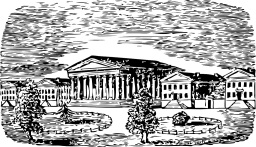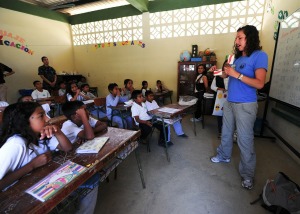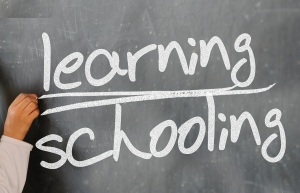Virtual School Leadership Has Its Roots in the Traditional School Setting
by Mark Sivy
Throughout the history of American education, the responsibilities of the school principal have evolved and become more complex. Despite the importance of this role when compared to other aspects of schools and district-level administration, relatively little historical research has been done on this position (Kafka, 2009; Rousmaniere, 2007).
 Until the early 1980s, school leaders had been viewed as managers of operations and programs (Irwin, 2002; Kafka, 2009; Rousmaniere, 2007). In 1983 with the release of A Nation at Risk, new demands and a greater emphasis were placed on the role of the school leader. With this publication calling for major school improvement efforts, the traditional roles of school leaders began rapidly evolving to meet the additional responsibilities and pressures of reform that were being placed on them. With the introduction of the No Child Left Behind (NCLB) legislation in 2001, there was the additional expectation for these administrators to provide strong instructional leadership.
Until the early 1980s, school leaders had been viewed as managers of operations and programs (Irwin, 2002; Kafka, 2009; Rousmaniere, 2007). In 1983 with the release of A Nation at Risk, new demands and a greater emphasis were placed on the role of the school leader. With this publication calling for major school improvement efforts, the traditional roles of school leaders began rapidly evolving to meet the additional responsibilities and pressures of reform that were being placed on them. With the introduction of the No Child Left Behind (NCLB) legislation in 2001, there was the additional expectation for these administrators to provide strong instructional leadership.
 Since the NCLB legislation, research has supported the assertion that increased effectiveness of school senior leadership is directly related to higher student achievement (Bottoms & Fry, 2009; Leithwood & Jantzi, 2008; Waters, Marzano, & McNulty, 2004). Research has also indicated that only the classroom teacher has a greater impact on traditional school success (Robinson, Lloyd, & Rowe, 2008). In the case of the school leader, how they execute their leadership can also influence their effectiveness. Mitello, Fusarelli, Alsbury, and Warren (2013) determined that there are three categories of leadership practice that are most prevalent in achieving intended school outcomes – collaboration focus, policy focus, and vision focus.
Since the NCLB legislation, research has supported the assertion that increased effectiveness of school senior leadership is directly related to higher student achievement (Bottoms & Fry, 2009; Leithwood & Jantzi, 2008; Waters, Marzano, & McNulty, 2004). Research has also indicated that only the classroom teacher has a greater impact on traditional school success (Robinson, Lloyd, & Rowe, 2008). In the case of the school leader, how they execute their leadership can also influence their effectiveness. Mitello, Fusarelli, Alsbury, and Warren (2013) determined that there are three categories of leadership practice that are most prevalent in achieving intended school outcomes – collaboration focus, policy focus, and vision focus.
Based on different researchers’ analyses of data from the Learning from Leadership Project, Wahlstrom (2008) identified four emergent themes that influence leader success when facilitating reform with the goal of improving student achievement:
- School context is key in any attempt to view and manage leadership.
- Relationships between leaders and those being led are neither linear nor uni-dimensional, meaning a more distributed and lateral distribution of responsibility and power.
- Belief systems, such as efficacy and trust, appear as powerful factors to enable leadership efforts to take hold.
- Most effects of educational leadership on student achievement are indirect. (p. 593)
 Additionally, the success of academic reform efforts and the adaptation to educational changes and innovations depends largely on local leadership being effective in gaining cooperation and in providing support (Bottoms & Fry, 2009; Leithwood, Seashore Louis, Anderson, & Wahlstrom, 2004; Murphy & Datnow, 2003). Bottoms and Fry (2009) found that senior leaders who were most effective in implementing reform were empowered to do such and able to work collaboratively with a district office that loosely controlled the process.
Additionally, the success of academic reform efforts and the adaptation to educational changes and innovations depends largely on local leadership being effective in gaining cooperation and in providing support (Bottoms & Fry, 2009; Leithwood, Seashore Louis, Anderson, & Wahlstrom, 2004; Murphy & Datnow, 2003). Bottoms and Fry (2009) found that senior leaders who were most effective in implementing reform were empowered to do such and able to work collaboratively with a district office that loosely controlled the process.
 Reflection Point – You can have great teachers, but if you don’t have a good principal, you won’t have a good school. ~Eli Broad
Reflection Point – You can have great teachers, but if you don’t have a good principal, you won’t have a good school. ~Eli Broad
References
Bottoms, G. & Fry, B. (2009). The district leadership challenge: Empowering principals to improve teaching and learning. Retrieved from the Southern Regional Education Board website: http://publications.sreb.org/2009/09V11_District_Leadership_Challenge_color.pdf.
Irwin, P. (2002). Life’s playbook. October, 3(2), 41-45.
Kafka, J. (2009). The principalship in historical perspective. Peabody Journal of Education, 84(3), 318-330.
Leithwood, K. & Jantzi, D. (2008). Linking leadership to student learning: The contributions of leader efficacy. Educational Administration Quarterly, 44, 496-528.
Leithwood, K., Seashore Louis, K., Anderson, S., & Wahlstrom, K. (2004). Review of research: How leadership influences student learning. Center for Applied Research and Educational Improvement, University of Minnesota and Ontario Institute for Studies in Education, University of Toronto.
Mitello, M., Fusarelli, B., Alsbury, T., & Warren, T. (2013). How professional standards guide practice for school principals. International Journal of Educational Management, 27(1), 74-90.
Murphy, J. & Datnow A. (2003). The development of comprehensive school reform. In J. Murphy & A. Datnow (Eds.), Leadership Lessons from Comprehensive School Reforms (pp. 3-17). Thousand Oaks, CA: Corwin Press, Inc.
Robinson, V., Lloyd, C., & Rowe, K. (2008). The impact of leadership on student outcomes: An analysis of the differential effects of leadership types. Educational Administration Quarterly, 44, 635-674.
Rousmaniere, K. (2006). Go to the principal’s office: Toward a social history of the school principal in North America. History of Education Quarterly, 47(1), 1-22.
Wahlstrom, K. (2008). Leadership and learning: What these articles tell us. Educational Administration Quarterly, 44, 593-597.
Waters, T., Marzano, R.J., & McNulty, B. (2004). McRELs’ balanced leadership framework: Developing the science of educational leadership. Retrieved from http://www.mdecgateway.org/olms/data/resource/4878/0404mcrel.pdf.
